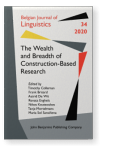Why we avoid the ‘Multiple Inheritance’ issue in Usage-based Cognitive Construction Grammar
This squib revisits the phenomenon of ‘Multiple Inheritance’ (MI) and discusses reasons why many usage-based,
cognitive construction grammarians seem to be avoiding it when modeling the constructicon and linguistic knowledge. After a brief
discussion of the concept and some examples from the literature, the paper examines potential reasons for the apparent
disinterest. Finally, the author points to some open questions regarding MI by discussing a specific example, namely modified NPN
constructions like day after hellish day or hour after hour of dominoes. It can be argued that
these strings inherit their characteristic features from several different abstract templates.
Article outline
- 1.Introduction
- 2.Multiple inheritance – Definition and examples
- 3.Avoidance of MI in usage-based cognitive constructional research
- 4.A concrete example – Modified NPN constructions
- 5.Conclusion
- Notes
-
References
References (38)
References
Blumenthal-Dramé, Alice. 2012. Entrenchment in Usage-Based Theories: What Corpus Data Do and Do Not Reveal About the Mind. Berlin/Boston: De Gruyter Mouton. 

Boas, Hans C. 2013. “Cognitive Construction Grammar.” In The Oxford Handbook of Construction Grammar, ed. by Thomas Hoffmann, and Graeme Trousdale, 233–254. Oxford: Oxford University Press.
Bybee, Joan. 2010. Language, Usage and Cognition. Cambridge: Cambridge University Press. 

Croft, William. 2001. Radical Construction Grammar: Syntactic Theory in Typological Perspective. Oxford: Oxford University Press. 

Diessel, Holger. 2011. “Review of Language, Usage and Cognition by Joan Bybee.” Language 871: 830–844. 

Diessel, Holger. 2015. “Usage-Based Construction Grammar.” In Handbook of Cognitive Linguistics, ed. by Ewa Dąbrowska, and Dagmar Divjak, 295–321. Berlin: Mouton de Gruyter. 

Diessel, Holger. 2019. The Grammar Network: How Linguistic Structure is Shaped by Language Use. Cambridge: Cambridge University Press. 

Divjak, Dagmar. 2019. Frequency in Language: Memory, Attention and Learning. Cambridge: Cambridge University Press. 

Fillmore, Charles, and Paul Kay. 1993. Construction Grammar Coursebook, Chapters 1–11 (Reading Materials for Ling X20). Berkeley: University of California, Berkeley.
Fried, Mirjam and Jan-Ola Östman. 2004. “Construction Grammar: A Thumbnail Sketch.” In Construction Grammar in a Cross-Language Perspective, ed. by Mirjam Fried, and Jan-Ola Östman, 11–86. Amsterdam/Philadelphia: John Benjamins. 

Ginzburg, Jonathan and Ivan A. Sag. 2000. Interrogative Investigations: The Form, Meaning, and Use of English Interrogatives. Stanford, CA: CSLI Publications.
Goldberg, Adele. E. 1995. Constructions: A Construction Grammar Approach to Argument Structure. Chicago: University of Chicago Press.
Goldberg, Adele E. 2006. Constructions at Work: The Nature of Generalization in Language. Oxford: Oxford University Press.
Goldberg, Adele E. 2013. “Constructionist Approaches.” In The Oxford Handbook of Construction Grammar, ed. by Thomas Hoffmann, and Graeme Trousdale, 15–31. Oxford: Oxford University Press.
Haïk, Isabelle. 2009. “Symmetric Structures.” CORELA 11(1). <[URL]> (Last accessed Nov 1st, 2018).
Hilpert, Martin. 2014. Construction Grammar and its Application to English. Edinburgh: Edinburgh University Press.
Hilpert, Martin, and Holger Diessel. 2016. “Entrenchment in Construction Grammar.” In Entrenchment and the Psychology of Language Learning, ed. by Hans-Jörg Schmid, 57–74. Berlin: Mouton de Gruyter.
Hoffmann, Thomas. 2013. “Abstract Phrasal and Clausal Constructions.” In The Oxford Handbook of Construction Grammar, ed. by Thomas Hoffmann, and Graeme Trousdale, 307–328. Oxford: Oxford University Press.
Hoffmann, Thomas, and Graeme Trousdale (eds.). 2013. The Oxford Handbook of Construction Grammar. Oxford: Oxford University Press. 

Hudson, Richard A. 2000. English Word Grammar. Oxford: Blackwell.
Jackendoff, Ray. 2002. Foundations of Language: Brain, Meaning, Grammar, Evolution. Oxford: Oxford University Press. 

Jackendoff, Ray. 2008. “‘Construction after Construction’ and Its Theoretical Challenges.” Language 84 (1): 8–28. 

Kim, Jong-Bok, and Peter Sells. 2015. “English Binominal NPs: A Construction-Based Perspective.” Journal of linguistics 51(1): 41–73. 

Lakoff, George. 1974. “Syntactic Amalgams.” Chicago Linguistic Society 101: 321–44.
Lakoff, George. 1987. Women, Fire and Dangerous Things: What Categories Reveal About the Mind. Chicago: University of Chicago Press. 

Langacker, Ronald W. 1988. “An Overview of Cognitive Grammar.” In Topics in Cognitive Linguistics, ed. by Brygida Rudzka-Ostyn, 3–48. Amsterdam/Philadelphia: John Benjamins. 

Michaelis, Laura A., and Knud Lambrecht. 1996. “Toward a Construction-Based Theory of Language Function: The Case of Nominal Extraposition.” Language 72 (2): 215–247. 

Sommerer, Lotte. forthcoming. “
Day to Day and Night After Night: Temporal NPN Constructions in English.” In English Noun Phrases from a Functional-Cognitive Perspective: Current Issues, ed. by Lotte Sommerer, and Evelien Keizer. Amsterdam/Philadelphia: John Benjamins.
Sommerer, Lotte and Andreas Baumann. 2021,aop. “Of Absent Mothers, Strong Sisters and Peculiar Daughters: The Constructional Network of English NPN
Constructions.” Cognitive Linguistics.
Tomasello, Michael. 2003. Constructing a Language: A Usage-Based Theory of Language Acquisition. Cambridge, MA: Harvard University Press.
Traugott, Elizabeth C., and Graeme Trousdale. 2013. Constructionalization and Constructional Changes. Oxford: Oxford University Press. 

Zwarts, Joost. 2013. “From N to N: The Anatomy of a Construction.” Linguistics and Philosophy 36 (1): 65–90. 

Cited by (3)
Cited by three other publications
This list is based on CrossRef data as of 9 october 2024. Please note that it may not be complete. Sources presented here have been supplied by the respective publishers.
Any errors therein should be reported to them.
